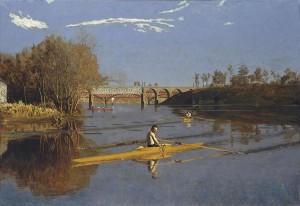Thomas Eakins, American Realist
Friday, June 24th, 2016June 24, 2016

The Champion Single Sculls (Max Schmitt in a Single Scull) (1871), oil on canvas by Thomas Eakins. Credit: The Alfred N. Punnett Endowment Fund and George D. Pratt Gift/The Metropolitan Museum of Art, New York City
Tomorrow, June 25, marks the 100th anniversary of the death of the great American Realist painter Thomas Eakins (1844-1916). At a time when many American painters were under the spell of new modern movements in Europe, Eakins believed that progress in American art should he home-grown. He spent most of his career in Philadelphia, Pennsylvania, and he painted the subjects he knew best—sports, outdoor recreation, domestic life, and the people of Philadelphia.
Eakins rejected the symbolism and sentimentality favored by many American artists of the later 1800’s. Using bold brushstrokes and thick layers of paint, Eakins filled his paintings with emotional truth as well as visual reality. While his style was honest and objective, it also reflected warmth and a feeling of compassion. These qualities appear in one of his most famous works, Walt Whitman (1887), his portrait of the American poet.
Eakins was born in Philadelphia on July 25, 1844. He began his art training in the early 1860’s at the Pennsylvania Academy of Fine Arts and studied anatomy at Jefferson Medical College. After studying art in Europe for four years, Eakins returned to Philadelphia in 1870 and taught at the Pennsylvania Academy of Fine Arts from 1876 to 1886. During these years, he became a leader of the Realist painters in the United States.
In 1875, Eakins completed The Clinic of Dr. Gross. One of the great paintings in American art, the work portrays the famous surgeon Samuel David Gross in an operating theater, performing an operation surrounded by students. The large painting was rejected as part of the official art gallery in the Centennial Exhibition world’s fair of 1876 because its bold naturalism was considered too graphic. A painting on a similar subject, The Clinic of Dr. Agnew (1889), did win a bronze medal at the World’s Columbian Exposition in 1893.
Eakins painted several famous pictures of sporting life, notably Max Schmitt in a Single Scull (1871), with its subtle effects of light and atmosphere, as well as several scenes of boxing and wrestling in the 1890’s. The portraits he completed later in his career are dominated by strong character studies of unsmiling men and women isolated against dark backgrounds. Eakins made a number of relief sculptures for public monuments in Trenton, New Jersey, and Brooklyn, New York. He also experimented with images on photographic plates in painting scenes of fishermen along the shore of the Delaware River and for studies leading up to his popular painting The Swimming Hole (1883-1885).


